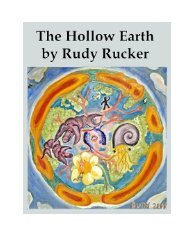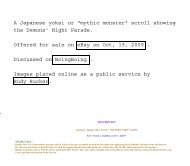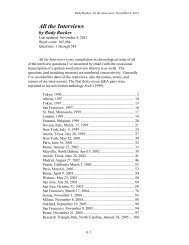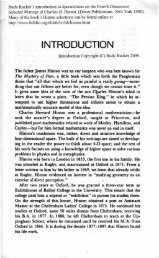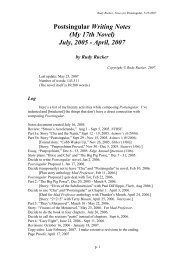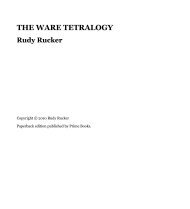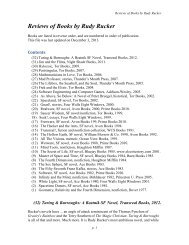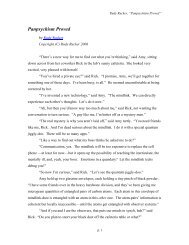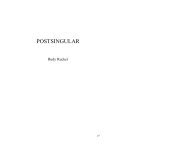Notes for the Lifebox, the Seashell, and the Soul - Rudy Rucker
Notes for the Lifebox, the Seashell, and the Soul - Rudy Rucker
Notes for the Lifebox, the Seashell, and the Soul - Rudy Rucker
Create successful ePaper yourself
Turn your PDF publications into a flip-book with our unique Google optimized e-Paper software.
<strong>Notes</strong> <strong>for</strong> The <strong>Lifebox</strong>, <strong>the</strong> <strong>Seashell</strong>, <strong>and</strong> <strong>the</strong> <strong>Soul</strong>, by <strong>Rudy</strong> <strong>Rucker</strong><br />
working with von Neumann at Los Alamos during those years. Ulam’s suggestion was that<br />
instead of talking about machine parts in a reservoir, von Neumann should think in terms of<br />
an idealized space of cells that could hold finite state-numbers representing different sorts of<br />
parts.<br />
Ulam’s first published reference to this idea reads as follows:<br />
An interesting field of application <strong>for</strong> models consisting of an<br />
infinite number of interacting elements may exist in <strong>the</strong> recent <strong>the</strong>ories<br />
of automata. A general model, considered by von Neumann <strong>and</strong> <strong>the</strong><br />
author, would be of <strong>the</strong> following sort:<br />
Given is an infinite lattice or graph of points, each with a finite<br />
number of connections to certain of its “neighbors.” Each point is<br />
capable of a finite number of “states.” The states of neighbors at time<br />
T n induce, in a specified manner, <strong>the</strong> state of <strong>the</strong> point at time T n+1 .<br />
One aim of <strong>the</strong> <strong>the</strong>ory is to establish <strong>the</strong> existence of<br />
subsystems which are able to multiply, i.e., create in time o<strong>the</strong>r<br />
systems identical (“congruent”) to <strong>the</strong>mselves. 3<br />
By 1952, von Neumann had completed a description of such a self-reproducing<br />
“cellular automaton” which uses 29 states. Von Neumann’s CA work was not published<br />
during his lifetime; it seems that once he saw <strong>the</strong> solution, he became distracted <strong>and</strong> moved<br />
on to o<strong>the</strong>r things.<br />
Wolfram On Discovering CAs<br />
It really is quite remarkable that, starting from an initial condition of a single marked<br />
cell, something as simple as a “Rule 30” can generate Class 3 r<strong>and</strong>omness <strong>and</strong> that a “Rule<br />
110” can generate a Class 4 process resembling a complex computation. In his own<br />
somewhat hyperbolic style, Wolfram expresses his excitement as follows.<br />
And what I found — to my great surprise — was that despite<br />
<strong>the</strong> simplicity of <strong>the</strong>ir rules, <strong>the</strong> behavior of programs was often far<br />
from simple. Indeed, even some of <strong>the</strong> very simplest programs that I<br />
looked at had behavior that was as complex as anything I’d ever seen<br />
... I have come to view [this result] as one of <strong>the</strong> more important single<br />
discoveries in <strong>the</strong> whole history of <strong>the</strong>oretical science. 4<br />
Ma<strong>the</strong>maticians have never discussed very much <strong>the</strong> fact that you can get<br />
complicated things from simple causes like CA Rule 30 or CA Rule 110. The one area<br />
where <strong>the</strong>y have talked a bit about complexity emerging from simple rules is in <strong>the</strong><br />
distribution of <strong>the</strong> primes <strong>and</strong> <strong>the</strong> irregularity of <strong>the</strong> digits of pi.<br />
Wolfram expresses surprise over this in <strong>the</strong>se words. “Often it seemed in retrospect<br />
3 From “R<strong>and</strong>om Processes <strong>and</strong> Trans<strong>for</strong>mations,” 1950, reprinted in : Stanislaw Ulam, Sets, Numbers<br />
<strong>and</strong> Universes, MIT Press, Cambridge 1974, p. 336.<br />
4 Stephen Wolfram, A New Kind of Science, p. 2.<br />
p. 68



